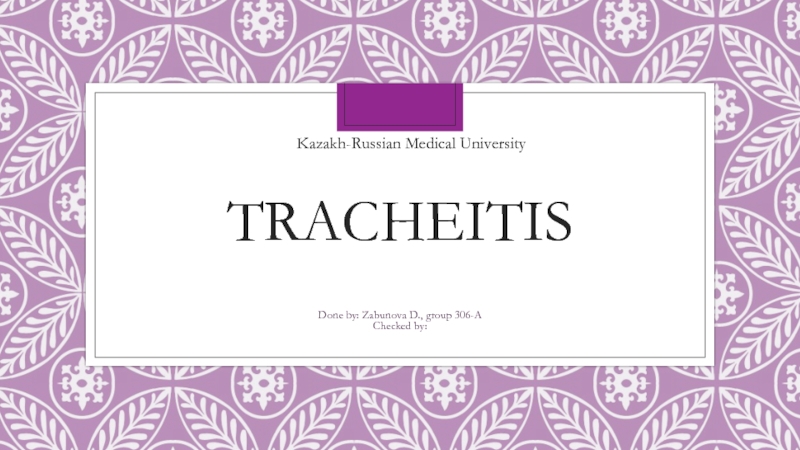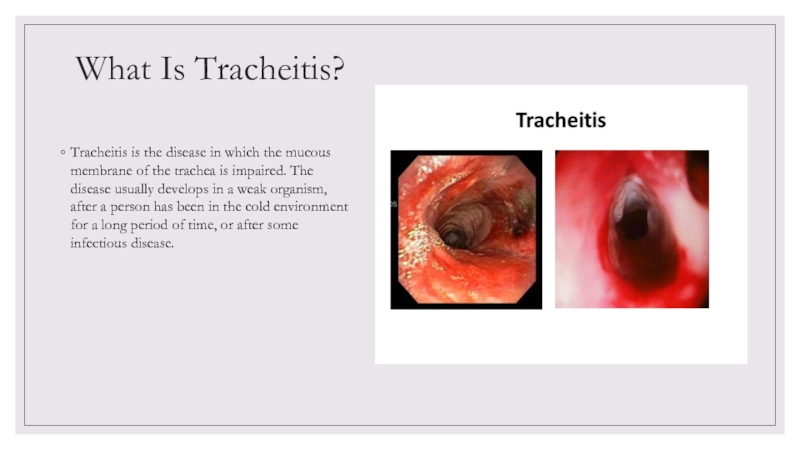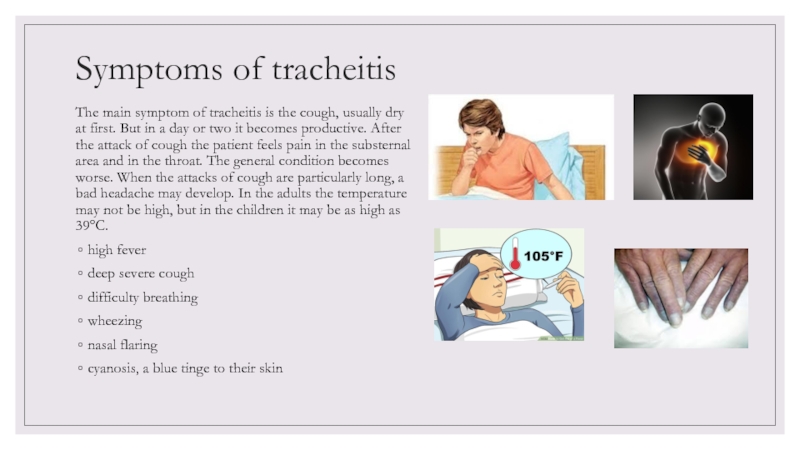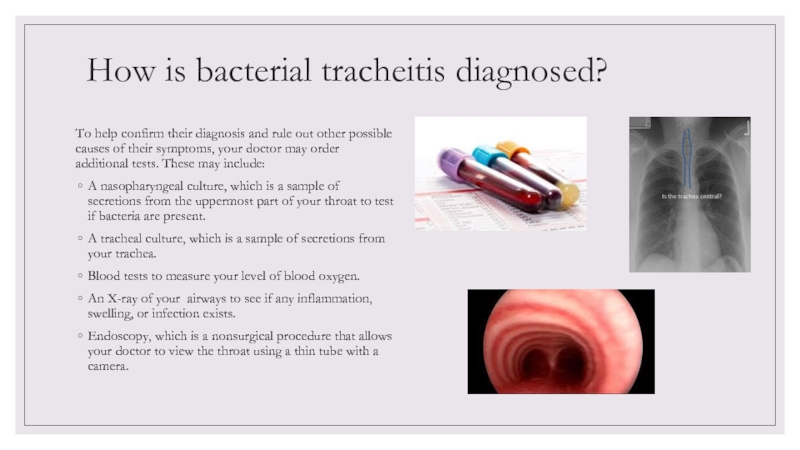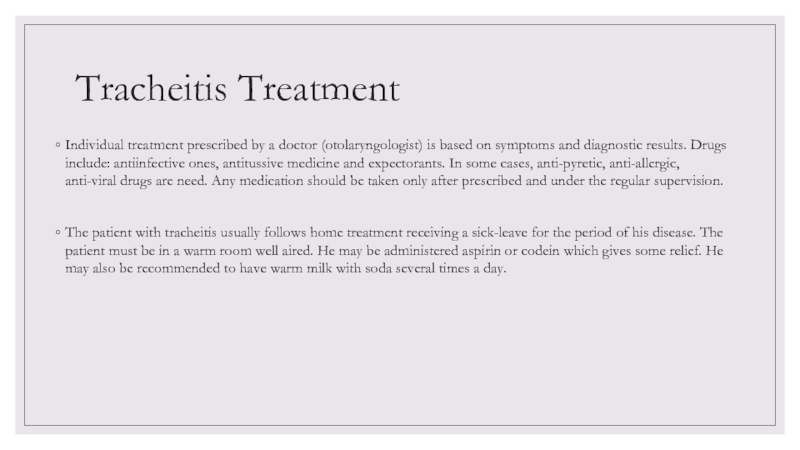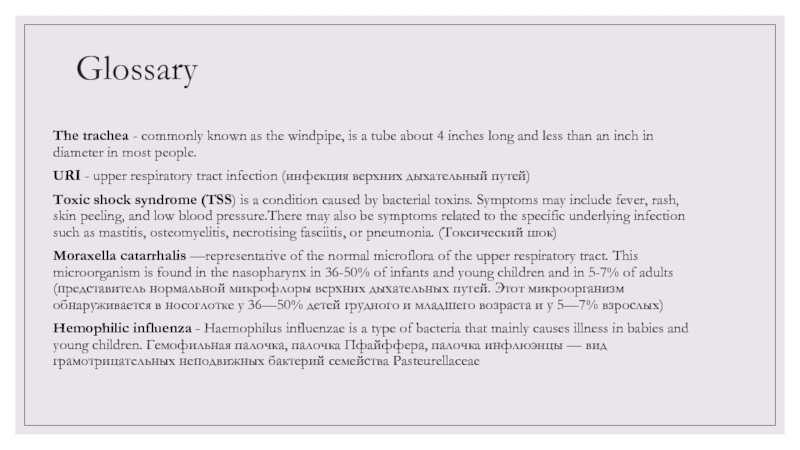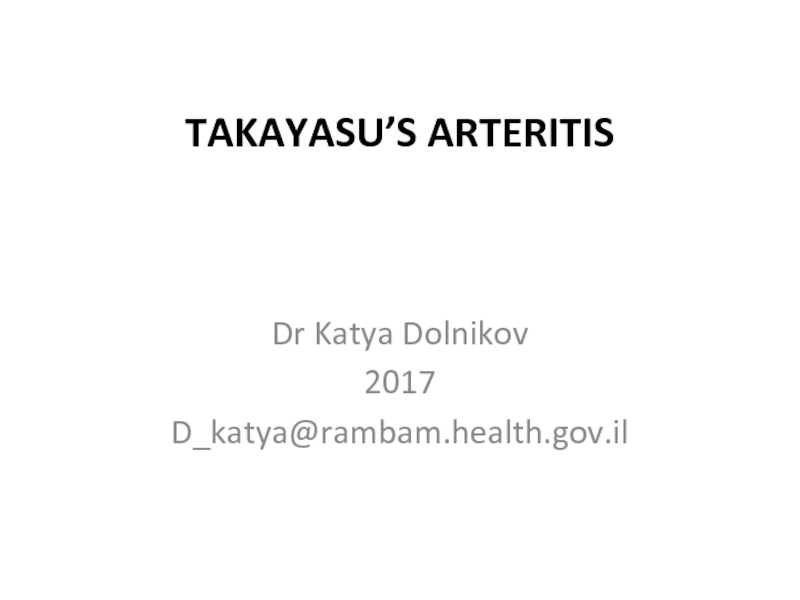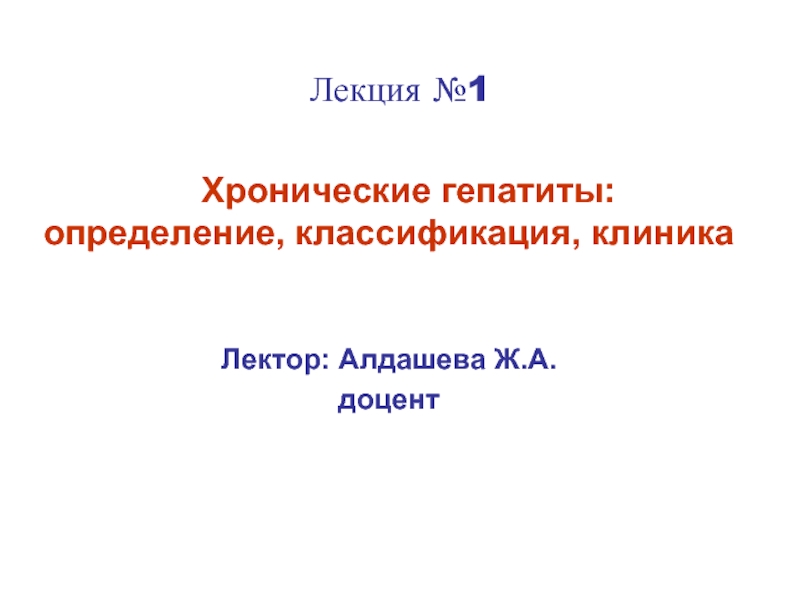- Главная
- Разное
- Дизайн
- Бизнес и предпринимательство
- Аналитика
- Образование
- Развлечения
- Красота и здоровье
- Финансы
- Государство
- Путешествия
- Спорт
- Недвижимость
- Армия
- Графика
- Культурология
- Еда и кулинария
- Лингвистика
- Английский язык
- Астрономия
- Алгебра
- Биология
- География
- Детские презентации
- Информатика
- История
- Литература
- Маркетинг
- Математика
- Медицина
- Менеджмент
- Музыка
- МХК
- Немецкий язык
- ОБЖ
- Обществознание
- Окружающий мир
- Педагогика
- Русский язык
- Технология
- Физика
- Философия
- Химия
- Шаблоны, картинки для презентаций
- Экология
- Экономика
- Юриспруденция
Tracheitis. The causes of tracheitis презентация
Содержание
- 1. Tracheitis. The causes of tracheitis
- 2. PLAN What Is Tracheitis? The causes of
- 3. What Is Tracheitis? Tracheitis is the
- 4. The causes of tracheitis Bacterial tracheitis is
- 5. Symptoms of tracheitis The main symptom
- 6. How is bacterial tracheitis diagnosed? To
- 7. Tracheitis Treatment Individual treatment prescribed by a
- 8. Complication of tracheitis Your outlook will depend
- 9. Glossary The trachea - commonly known
Слайд 2PLAN
What Is Tracheitis?
The causes of tracheitis
Symptoms of tracheitis
How is bacterial tracheitis
diagnosed?
Tracheitis Treatment
Glossary
Tracheitis Treatment
Glossary
Слайд 3What Is Tracheitis?
Tracheitis is the disease in which the mucous membrane
of the trachea is impaired. The disease usually develops in a weak organism, after a person has been in the cold environment for a long period of time, or after some infectious disease.
Слайд 4The causes of tracheitis
Bacterial tracheitis is usually caused by Staphylococcus aureus
bacteria. Other bacteria can also cause it, including:
Streptococcus pneumonia
Hemophilic influenza
Moraxella catarrhalis
Most cases of bacterial tracheitis develop after a common cold or flu. Following an URI, bacteria can more easily invade your child’s trachea. This can cause infection, inflammation, and rapid swelling
Streptococcus pneumonia
Hemophilic influenza
Moraxella catarrhalis
Most cases of bacterial tracheitis develop after a common cold or flu. Following an URI, bacteria can more easily invade your child’s trachea. This can cause infection, inflammation, and rapid swelling
Staphylococcus aureus
Streptococcus pneumonia
Hemophilic influenza
Moraxella catarrhalis
Слайд 5Symptoms of tracheitis
The main symptom of tracheitis is the cough, usually
dry at first. But in a day or two it becomes productive. After the attack of cough the patient feels pain in the substernal area and in the throat. The general condition becomes worse. When the attacks of cough are particularly long, a bad headache may develop. In the adults the temperature may not be high, but in the children it may be as high as 39°C.
high fever
deep severe cough
difficulty breathing
wheezing
nasal flaring
cyanosis, a blue tinge to their skin
high fever
deep severe cough
difficulty breathing
wheezing
nasal flaring
cyanosis, a blue tinge to their skin
Слайд 6How is bacterial tracheitis diagnosed?
To help confirm their diagnosis and rule
out other possible causes of their symptoms, your doctor may order additional tests. These may include:
A nasopharyngeal culture, which is a sample of secretions from the uppermost part of your throat to test if bacteria are present.
A tracheal culture, which is a sample of secretions from your trachea.
Blood tests to measure your level of blood oxygen.
An X-ray of your airways to see if any inflammation, swelling, or infection exists.
Endoscopy, which is a nonsurgical procedure that allows your doctor to view the throat using a thin tube with a camera.
A nasopharyngeal culture, which is a sample of secretions from the uppermost part of your throat to test if bacteria are present.
A tracheal culture, which is a sample of secretions from your trachea.
Blood tests to measure your level of blood oxygen.
An X-ray of your airways to see if any inflammation, swelling, or infection exists.
Endoscopy, which is a nonsurgical procedure that allows your doctor to view the throat using a thin tube with a camera.
Слайд 7Tracheitis Treatment
Individual treatment prescribed by a doctor (otolaryngologist) is based on
symptoms and diagnostic results. Drugs include: antiinfective ones, antitussive medicine and expectorants. In some cases, anti-pyretic, anti-allergic, anti-viral drugs are need. Any medication should be taken only after prescribed and under the regular supervision.
The patient with tracheitis usually follows home treatment receiving a sick-leave for the period of his disease. The patient must be in a warm room well aired. He may be administered aspirin or codein which gives some relief. He may also be recommended to have warm milk with soda several times a day.
The patient with tracheitis usually follows home treatment receiving a sick-leave for the period of his disease. The patient must be in a warm room well aired. He may be administered aspirin or codein which gives some relief. He may also be recommended to have warm milk with soda several times a day.
Слайд 8Complication of tracheitis
Your outlook will depend on the severity of their
condition and how quickly they get treatment.
If your infection is caused by S. aureus bacteria, they can also potentially develop toxic shock syndrome. This condition can cause fever, shock, organ failure, and even death.
If your infection is caused by S. aureus bacteria, they can also potentially develop toxic shock syndrome. This condition can cause fever, shock, organ failure, and even death.
Слайд 9Glossary
The trachea - commonly known as the windpipe, is a tube
about 4 inches long and less than an inch in diameter in most people.
URI - upper respiratory tract infection (инфекция верхних дыхательный путей)
Toxic shock syndrome (TSS) is a condition caused by bacterial toxins. Symptoms may include fever, rash, skin peeling, and low blood pressure.There may also be symptoms related to the specific underlying infection such as mastitis, osteomyelitis, necrotising fasciitis, or pneumonia. (Токсический шок)
Moraxella catarrhalis —representative of the normal microflora of the upper respiratory tract. This microorganism is found in the nasopharynx in 36-50% of infants and young children and in 5-7% of adults (представитель нормальной микрофлоры верхних дыхательных путей. Этот микроорганизм обнаруживается в носоглотке у 36—50% детей грудного и младшего возраста и у 5—7% взрослых)
Hemophilic influenza - Haemophilus influenzae is a type of bacteria that mainly causes illness in babies and young children. Гемофильная палочка, палочка Пфайффера, палочка инфлюэнцы — вид грамотрицательных неподвижных бактерий семейства Pasteurellaceae
URI - upper respiratory tract infection (инфекция верхних дыхательный путей)
Toxic shock syndrome (TSS) is a condition caused by bacterial toxins. Symptoms may include fever, rash, skin peeling, and low blood pressure.There may also be symptoms related to the specific underlying infection such as mastitis, osteomyelitis, necrotising fasciitis, or pneumonia. (Токсический шок)
Moraxella catarrhalis —representative of the normal microflora of the upper respiratory tract. This microorganism is found in the nasopharynx in 36-50% of infants and young children and in 5-7% of adults (представитель нормальной микрофлоры верхних дыхательных путей. Этот микроорганизм обнаруживается в носоглотке у 36—50% детей грудного и младшего возраста и у 5—7% взрослых)
Hemophilic influenza - Haemophilus influenzae is a type of bacteria that mainly causes illness in babies and young children. Гемофильная палочка, палочка Пфайффера, палочка инфлюэнцы — вид грамотрицательных неподвижных бактерий семейства Pasteurellaceae
